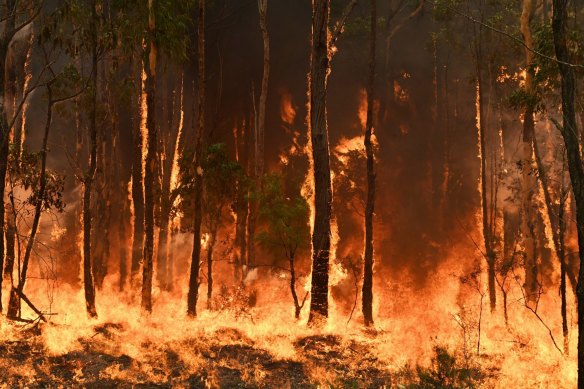Revealing the Risks: Why Every Homeowner Requirements a Bushfire Risk Assessment
Revealing the Risks: Why Every Homeowner Requirements a Bushfire Risk Assessment
Blog Article
Vital Tips for Bushfire Management to Guarantee Fire Defense

Understanding Bushfire Threat Degrees
Comprehending the varying degrees of bushfire threat is necessary for efficient planning and prep work in mitigating prospective threats to buildings and lives. Bushfire danger degrees are commonly classified based on elements such as climate condition, fuel availability, topography, and historic fire actions. By understanding these danger areas, degrees and people can proactively apply strategies to lower susceptability and improve resilience when faced with prospective bushfire events.
The initial degree of bushfire threat is reduced threat, where the probability of a bushfire taking place and triggering substantial harm is marginal. High-risk levels indicate a substantial danger, with problems conducive to quick fire spread and extreme fire habits.
Recognizing these bushfire threat degrees enables stakeholders to customize their readiness and reaction actions accordingly, ensuring a proactive and reliable approach to bushfire monitoring.
Establishing a Defensible Room
Efficient bushfire administration begins with establishing a defensible area around properties to boost defense versus possible fire dangers. A defensible space is a barrier zone that produces a barrier in between a framework and the surrounding combustible plant life. This room works as an important line of protection, providing firemens a safe location to operate and helping to lower the danger of a fire spreading out to the residential property.
When establishing a defensible area, it is essential to consider the format of the residential or commercial property and the bordering landscape. Clearing up greenery, especially extremely combustible plants, within a particular span of the building can aid avoid the rapid spread of fires. In addition, keeping a well-irrigated zone around the property can further boost its defensibility.
Normal maintenance of the defensible space is essential to guarantee its efficiency. This includes trimming overhanging branches, clearing dead greenery, and keeping the area complimentary of debris. By spending time and initiative right into establishing and maintaining a defensible space, homeowner can substantially enhance their opportunities of shielding their homes and properties during a bushfire.
Applying Fire-Resistant Landscaping
When making landscapes to mitigate the danger of bushfires, integrating fireproof elements is crucial for improving residential or commercial property security and reducing fire threats. Select plants with high wetness content, low oil web content, and very little find out here dead greenery to reduce the danger of fire spread.

Developing an Emergency Situation Evacuation Plan
Developing a detailed emergency situation emptying strategy is critical for ensuring the safety and wellness of individuals during prospective bushfire cases (BAL Assessment). An effective discharge plan should lay out clear treatments to adhere to in the event of a bushfire threat, including designated discharge routes, assembly factors, and interaction methods
To begin producing an emergency situation evacuation strategy, it is vital to examine the particular threats and susceptabilities of your place. Identify multiple evacuation routes that result in risk-free locations far from the fire, taking into consideration factors such as terrain, road access, and potential dangers. Develop interaction networks to sharp residents of an impending emptying, using techniques such as alarms, message signals, or door-to-door alerts.
Consistently review and exercise the discharge strategy with all homeowners or area participants to guarantee every person recognizes their responsibilities and duties. Conduct drills to check the performance of the strategy and make any type of required adjustments. By having a well-prepared evacuation strategy in area, you can enhance the possibilities of a organized and secure discharge during a bushfire emergency situation.
Maintaining Fire Safety Devices
After developing a comprehensive emergency situation evacuation plan for bushfire cases, it is vital to prioritize the normal upkeep of fire safety equipment to make certain ideal functionality and readiness. Routine maintenance of fire safety and security tools such as fire extinguishers, smoke alarm, emergency alarm, and sprinkler systems is vital in securing lives and building during a bushfire. Conducting regular assessments, testing, and servicing of these tools by certified experts is essential to assure they are in working order when needed.
Fire extinguishers should be inspected routinely for stress levels, visible damages, and proper capability. Smoke detectors should have Visit Your URL their batteries replaced a minimum of annually and undergo regular monthly testing to ensure they are functional. Smoke alarm and automatic sprinkler must be inspected regularly to validate they are connected and working correctly. Additionally, it is essential to keep fire safety and security devices obtainable, unobstructed, and plainly labeled for easy identification during an emergency. By diligently preserving fire safety and security tools, people can improve their readiness and reaction abilities in case of a bushfire.
Final Thought
In final thought, reliable bushfire monitoring includes comprehending danger levels, creating defensible spaces, applying fireproof landscaping, creating discharge strategies, and preserving fire safety equipment. By adhering to these crucial pointers, individuals can make certain much better fire protection and safety for their residential properties and communities. It is necessary to prioritize positive procedures to alleviate the risks linked with bushfires and to be planned for emergency situations.
By comprehending the nuances of bushfire threat levels, developing defensible spaces, applying fire-resistant landscape design, developing detailed evacuation plans, and making sure the maintenance of fire safety devices, communities and people can considerably boost their strength against the devastations of wildfires - BAL Assessment. These ideas are not just critical for securing versus prompt fire dangers yet likewise for cultivating long-term fire protection methods that can make a significant distinction in the face of rising bushfire threats
Risky degrees signify a significant risk, with conditions conducive to quick fire spread and severe fire actions. Regular maintenance of fire security devices such as fire extinguishers, smoke detectors, fire alarm systems, and lawn sprinkler systems is important in guarding lives and building throughout a bushfire.In verdict, effective bushfire administration includes recognizing threat degrees, developing defensible rooms, executing fire-resistant landscaping, establishing emptying strategies, and keeping fire safety and security More Info equipment.
Report this page